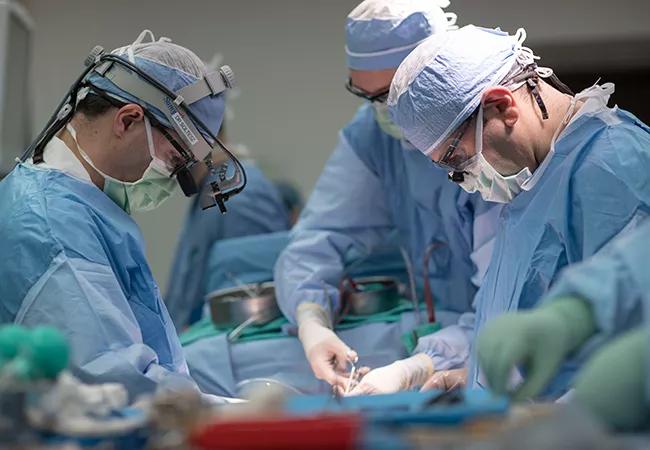Keys are deep experience, image guidance, meticulous planning and a team approach

At high-volume centers with meticulous preoperative planning, the surgical risk of reoperative cardiac surgery can be driven down to levels approaching those of primary cardiac surgery.
Advertisement
Cleveland Clinic is a non-profit academic medical center. Advertising on our site helps support our mission. We do not endorse non-Cleveland Clinic products or services. Policy
So suggests an observational outcomes study among more than 6,600 reoperative cardiac surgery cases over a recent 9.5-year period at Cleveland Clinic.
The study, published online in the Journal of Thoracic and Cardiovascular Surgery, revealed overall reoperative mortality of 3.5% and low rates of stroke, renal failure, deep sternal wound infection and other complications despite high case complexity. Outcomes were comparably favorable regardless of whether cardiopulmonary bypass (CPB) was instituted early or late.
“These results are exceptional because they included emergency procedures, endocarditis cases and patients with multiple previous sternotomies,” says the study’s corresponding author, cardiothoracic surgeon Faisal Bakaeen, MD. “Many patients were referred from other hospitals or were self-referred, with some deemed ‘inoperable’ prior to evaluation at Cleveland Clinic. These findings are a testament to the value of volume-based surgical experience and the use of a multidisciplinary heart team approach when evaluating risk of sternal reentry and choosing a surgical strategy for reoperative cases.”
“Our findings constitute strong evidence that reoperative sternotomy is safe and adds only minimally to operative risk when done by experienced teams,” adds co-author Lars Svensson, MD, PhD, Chair of Cleveland Clinic’s Miller Family Heart, Vascular & Thoracic Institute.
These surgeons and their colleagues undertook the analysis to assess current practice and outcomes of reoperative surgery, with a focus on the use of image-guided stratification of sternal reentry risk and the usefulness of peripheral cannulation to initiate CPB prior to resternotomy.
Advertisement
“Peripheral cannulation and early cardiopulmonary bypass are employed to avoid or attenuate catastrophic injury and manipulation, but their routine use is controversial due to the need for early heparinization and risks of excessive bleeding and cardiopulmonary bypass time,” says Dr. Bakaeen. “We sought greater insight on their effects in real-world practice.”
The researchers examined records of all 7,640 patients who underwent reoperative cardiac surgery at Cleveland Clinic from January 2008 to July 2017. Patients without preoperative CT scans, those who did not undergo resternotomy or CPB, and those who underwent heart transplant or endovascular stenting of the thoracic aorta were excluded. The remaining 6,627 patients made up the study cohort and were stratified in two ways:
Endpoints were operative mortality and major morbidity (i.e., stroke, myocardial infarction, prolonged ventilation, renal failure with dialysis, deep sternal wound infection). Within each anatomic risk group, weighted propensity scores for mortality and morbidity were generated to allow comparisons by timing of CPB.
Reoperations most commonly included aortic valve replacement (n = 3,611), coronary artery bypass grafting (CABG) (n = 2,029), aortic root surgery (n = 1,061) and aortic arch surgery (n = 527).
Advertisement
Operative mortality for the full cohort was 3.5% (235/6,627), with statistically comparable rates of 4.1% and 3.5% in the early and late CPB groups, respectively. Major sternal reentry and mediastinal dissection injuries were uncommon (2.8% incidence).
In the high anatomic risk cohort, propensity-weighted analysis revealed no significant differences in mortality or in any major morbidities between the early and late CPB groups. There was likewise no significant difference in long-term survival. The only significant between-group differences were in intraoperative blood product transfusions, which were higher in the early CPB group, and postoperative platelet infusions, which were higher in the late CPB group.
In the low anatomic risk cohort, propensity-weighted analysis again showed similar operative and long-term mortality rates and rates of all major morbidities between the early and late CPB groups. However, the late CPB group experienced significantly higher rates of major reentry and dissection injuries (2.8% vs. 0.8%) and had longer myocardial ischemic times and higher rates of postoperative atrial fibrillation. As in the high-risk cohort, significantly more patients in the early CPB group required intraoperative blood product transfusions.
“This study shows that reoperative cardiac surgery can be performed with high levels of safety and few major sternal reentry and mediastinal dissection injuries regardless of the timing of cardiopulmonary bypass,” says Dr. Bakaeen. “The key ingredient is volume-based experience using established quality and rescue protocols.”
Advertisement
In their study report, the authors outline specific critical elements — in addition to institutional experience — that contribute to reoperative success, as summarized below:
Advertisement
Adoption or enhancement of these elements may help explain improvements from a previous Cleveland Clinic series of reoperative cases, published in 2008. Overall reoperative mortality declined from 4.5% in that earlier report to 3.5% in the present study, and rates of major reentry- and dissection-associated injuries were reduced by more than half. “Since that earlier series,” the authors write, “we have mandated preoperative CT scans and more consistently adopted common reoperative strategies and surgical practices to prevent adverse events.”
While the current analysis found no outcome benefits with one CPB timing strategy over the other, the authors identify several scenarios where a particular approach may be favored.
An early CPB strategy or endovascular adjunct is advised when imaging findings suggest a high risk of injury — such as adherence of an aortic pseudoaneurysm or a patent bypass graft to the chest wall — and when performing isolated aortic valve or aorta surgery. In contrast, a late CPB strategy is favored for CABG and mitral valve surgery in cases with low anatomic risk and in multicomponent operations that demand extensive dissection.
In a commentary that accompanied the study in the Journal of Thoracic and Cardiovascular Surgery, two cardiac surgeons from Sunnybrook Health Sciences Center in Toronto commend the Cleveland Clinic authors for “encouraging the cardiac surgical community that redo surgery can consistently result in positive outcomes and may trend toward outcomes similar to primary surgery.”
They further write that the study presents “a potential pathway forward toward reducing surgical risk with reoperation that may be generalizable to a greater number of surgical centers.”
Cleveland Clinic’s Dr. Svensson concurs that there are lessons here for other high-volume centers. “Our results demonstrate that redo operations do not of necessity add to procedural risk,” he says. “Prior sternotomy should not prohibit treatment or prompt automatic or inappropriate triage to transcatheter valve-in-valve procedures or percutaneous or endovascular repairs. In experienced hands, reoperations are safe and can yield excellent outcomes.”
Advertisement

30-year study of Cleveland Clinic experience shows clear improvement from year 2000 onward

Launch of the tool promises to reshape quality assessment across the specialty

Cleveland Clinic series finds favorable long-term results with this high-risk operation

Surgeons credit good outcomes to experience with complex cases and team approach

Study indicates lower in-hospital mortality and better long-term survival

20 years of Cleveland Clinic experience in ~500 patients with proximal aortic aneurysm or dilation

Why and how we’re using robotic assistance for qualifying CABG candidates

Multicenter pivotal study may lead to first endovascular treatment for the ascending aorta